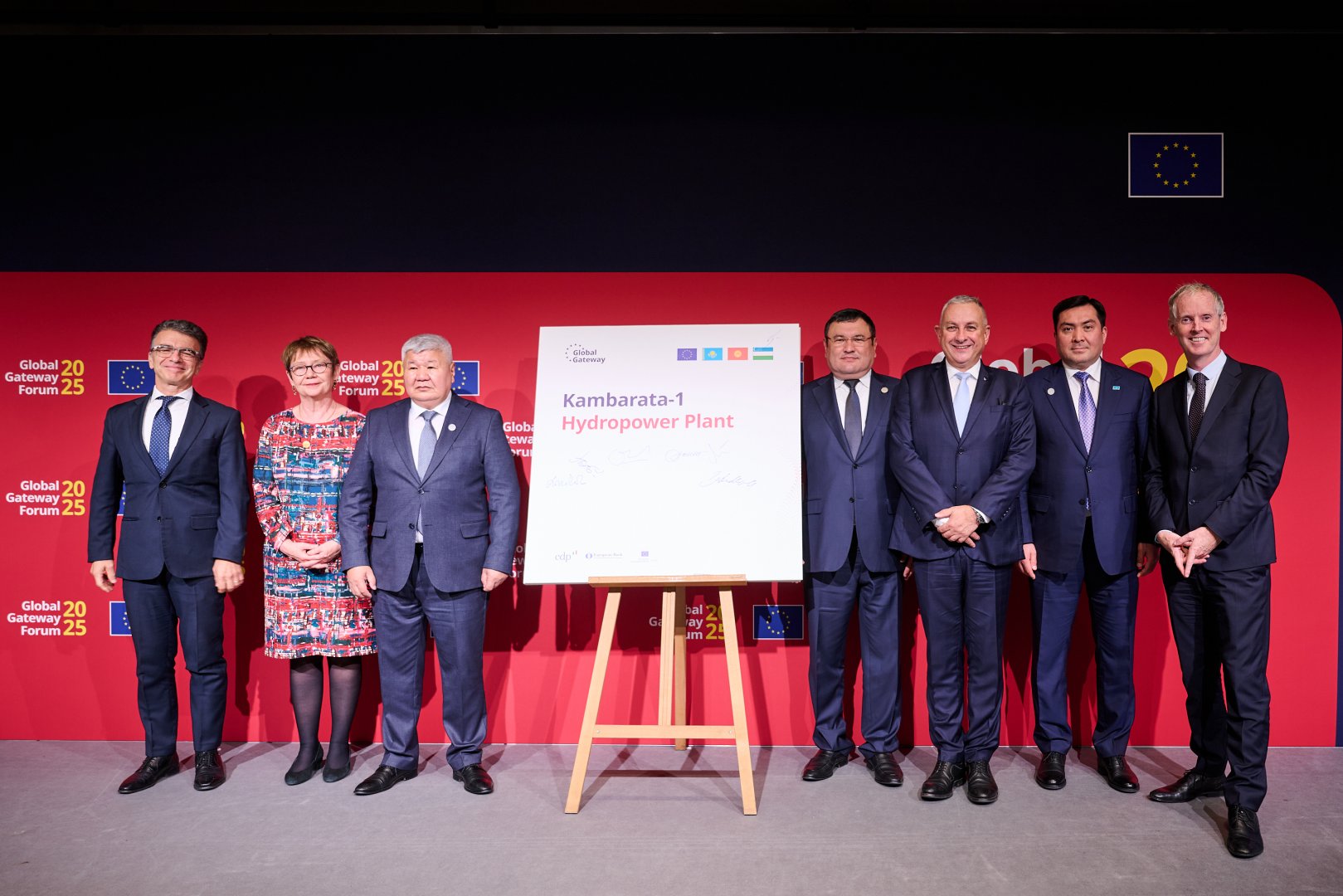BAKU, Azerbaijan, October 13. As glaciers shrink and rivers thin, Central Asia is confronting an uncomfortable truth: its most precious resource - water - is running out. In a region where every drop fuels both lights and livelihoods, the old competition over water is turning into an urgent call for cooperation.
That shift was on full display last week in Brussels, where the European Union and its partners unveiled a wave of new investments aimed at tackling the region’s water and energy challenges. At the heart of the announcement was the Kambarata-1 hydropower project in Kyrgyzstan - a long-discussed dream that’s finally moving from blueprint to reality.
Kambarata-1 is poised to become the largest hydropower facility in Kyrgyzstan and one of the biggest in Central Asia. Rising on the Naryn River, it will generate about 1,860 MW of clean energy and store more than five billion cubic meters of water behind its dam - enough to power over a million homes and stabilize irrigation flows across the region.
At the Global Gateway Forum, the EU and the European Investment Bank (EIB) signed 900 million euros in agreements with Kyrgyzstan, Kazakhstan, and Uzbekistan, while the European Bank for Reconstruction and Development (EBRD) signaled plans to mobilize another 1.3 billion euros. The EU and the World Bank will also co-fund a feasibility study - a crucial step before construction begins on the roughly $5-6 billion megaproject.
For Kyrgyzstan, this marks the revival of a project first imagined decades ago but stalled for lack of financing and consensus. For the region, it could become a turning point - a shared investment in both clean energy and shared stability.
European officials are framing the project as a model for sustainable cooperation.
"During my recent mission across Central Asia, I have very well learned the importance of water for the stability of the whole region," said Jozef Síkela, European Commissioner for International Partnerships. "Smart investments in hydropower can improve access to reliable and affordable electricity, generate income for local people, while supporting sustainable agriculture and protecting the environment. We are proud to support the future construction of the Kambarata-1 hydropower plant".
From the financing side, EIB Vice-President Kyriacos Kakouris called Kambarata-1 "instrumental in expanding renewable electricity trade in the region, fostering economic development, and enhancing energy security".
And for the EBRD, which has operations in all three partner countries, the project is about more than megawatts. "Kambarata-1 is a flagship regional project for Central Asia," said Odile Renaud-Basso, the bank’s President. "It enhances energy and water security and supports the expansion of renewable energy. We are pleased to support regional connectivity and effective water management, with the EU and partners".
Hydropower in Central Asia has long been a source of friction. Upstream countries like Kyrgyzstan and Tajikistan control the headwaters, while downstream Uzbekistan and Kazakhstan depend on the same rivers for agriculture. For years, the two sides clashed over seasonal water releases and winter energy shortages.
Kambarata-1 could mark a turning of the tide. By giving each country a stake in the project’s ownership and output, it ties their energy and irrigation futures together. Shared infrastructure becomes shared interest - a rare alignment in a region historically divided by water politics.
Kambarata-1 isn’t the only megaproject reshaping the landscape. In neighboring Tajikistan, the Rogun hydropower plant - home to the world’s tallest dam - is expected to double the country’s power output by 2032 and transform it into a net exporter of electricity.
Both Kambarata and Rogun fall under the EU’s Team Europe Initiative on Water, Energy and Climate Change, which aims to help Central Asia adapt to climate change while building cross-border energy links. The logic is simple: energy and water security can’t be solved within borders that rivers ignore.
That cooperation is also extending beyond energy. On the sidelines of the Forum, Kyrgyz Deputy Finance Minister Ulugbek Kalenderov and EU Director for Asia and the Pacific Peteris Ustubs signed a 17 million euro grant for comprehensive water-sector reforms - from modernizing irrigation systems to improving sustainable water use.
Still, turning these promises into power is no easy task. Kambarata-1 will require unprecedented coordination, strict environmental oversight, and billions in long-term financing. The dam’s location - in a seismically active zone - adds another layer of complexity.
Environmental groups have urged caution, warning that regulating the Naryn could alter downstream ecosystems and affect farmers in the Ferghana Valley. Development banks insist those risks will be addressed through transparent impact assessments and public consultations.
For Europe, the project is about more than climate action - it’s about building lasting partnerships in a region long courted by other powers. Through the Global Gateway, the EU is positioning itself as a stable, values-based alternative to opaque financing models.
As EIB’s VP Kakouris said in an exclusive interview with Trend, EIB Global’s activities in Central Asia are fully aligned with the European Union’s Global Gateway strategy.
"We provide technical assistance and advisory services to ensure projects are bankable, sustainable, and aligned with EU standards. We often blend EU grants with EIB loans and equity to reduce financial risk and accelerate project preparation," he explained.
The EIB is preparing to open its first Regional Representation in Central Asia, marking a new milestone in the bank’s engagement with the region.
The new office will serve as a regional hub for coordinating EIB Global’s activities across Central Asia. "It will deepen our engagement under Global Gateway," Kakouris noted, adding that "having staff on the ground will strengthen cooperation with both the public and private sectors".
In other words, this is Europe’s green diplomacy in action - helping the region generate not just electricity, but stability.
If Kambarata-1 succeeds, it could rewrite Central Asia’s narrative: from water tension to water partnership, from scarcity to shared sustainability.
Hydropower alone won’t solve the region’s challenges, but it can buy something just as vital - time. Time to modernize agriculture, invest in efficiency, and strengthen institutions before climate change turns the trickle into a crisis.
For now, the message from Brussels to Bishkek is clear: the rivers that once divided Central Asia might just become the currents that unite it.







